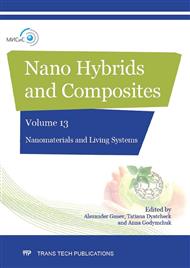[1]
S. Shamaila, H. Wali, R. Sharif, J. Nazir, N. Zafar et al, Antibacterial effects of laser ablated Ni nanoparticles, Appl. Phys. Lett. 103 (2013) 153701.
DOI: 10.1063/1.4824331
Google Scholar
[2]
P.R. Chetana, M.N. Somashekar, B.S. Srinatha, R.S. Policegoudra, S.M. Aradhya, R. Rao, Synthesis, Crystal Structure, Antioxidant, Antimicrobial, and Mutagenic Activities and DNA Interaction Studies of Ni(II) Schiff Base 4-Methoxy-3-benzyloxybenzaldehyde Thiosemicarbazide Complexes, Inorg. Chem. 2013 (2013).
DOI: 10.1155/2013/250791
Google Scholar
[3]
L.W. Xue, X.W. Li, G.Q. Zhao, W.C. Yang, Synthesis, structures, and antimicrobial activity of nickel(II) and zinc(II) complexes with Schiff bases derived from 3-bromosalicylaldehyde, Russian J. Coord. Chem. 39 (12) (2013) 872-876.
DOI: 10.1134/s1070328413110092
Google Scholar
[4]
P.B. Koli, K.H. Kapadnis, Synthesis, Characterization & Antimicrobial Activity of Mixed Metal Oxides of Iron Cobalt Nickel and Zinc, Int. J. Chem. and Phys. Sci. 4 (2015) ISSN: 2319-6602.
Google Scholar
[5]
A.K. Horst, Antimicrobial effects of metal oxide nanoparticles, In The 2009 Research Accomplishments. Ithaca: NNIN. (2009) 12–13.
Google Scholar
[6]
H. Kumar, R. Rani, R. Salar, Reverse Micellar Synthesis, Characterization and antibacterial study of nickel nanoparticles, Adv. in Control, Chem., Civil and Mechanical Eng. 17 (2010) 88-94.
Google Scholar
[7]
M. Kokkoris, C.C. Trapalis, S. Kossionides, R. Vlastouc, B. Nsouli, R. Grotzschel, S. Spartalis, G. Kordas, Th. Paradellis, RBS and HIRBS studies of nanostructured AgSiO2 sol–gel thin coatings, Nucl. Instrum. Meth. B. 188 (2002) 67-72.
DOI: 10.1016/s0168-583x(01)01020-5
Google Scholar
[8]
Y. Ge, J.P. Schimel, P.A. Holden, Evidence for negative effects of TiO2 and ZnO nanoparticles on soil bacterial communities, Environ. Sci. Technol. 45 (2011) 1659-1664.
DOI: 10.1021/es103040t
Google Scholar
[9]
Y. Ge, J.P. Schimel, P.A. Holden, Identification of soil bacteria susceptible to TiO2 and ZnO nanoparticles, Appl. Environ. Microbiol. 78 (2012) 6749-6758.
DOI: 10.1128/aem.00941-12
Google Scholar
[10]
Y. Ge, J.H. Priester, L.C. van der Werfhorst, S.L. Walker, R.M. Nisbet, Y. -J. An, J.P. Schimel, J.L. Gardea-Torresdey, P.A. Holden, Soybean plants modify metal oxide nanoparticle effects on soil bacterial communities, Environ. Sci. Technol. 48 (2014).
DOI: 10.1021/es5031646
Google Scholar
[11]
W. Du, Y. Sun, R. Ji, J. Zhu, J. Wu, H. Guo, TiO2 and ZnO nanoparticles negatively affect wheat growth and soil enzyme activities in agricultural soil, J. Env. Monitor. 13 (2011) 822-828.
DOI: 10.1039/c0em00611d
Google Scholar
[12]
S. Kim, J. Kim, I. Lee, Effects of Zn and ZnO nanoparticles and Zn2+ on soil enzyme activity and bioaccumulation of Zn in Cucumis sativus, Chem. Ecol. 27 (2011) 49–55.
DOI: 10.1080/02757540.2010.529074
Google Scholar
[13]
H. Chai, J. Yao, J. Sun, C. Zhang, W. Liu, M. Zhu, B.C. Bull, The effect of metal oxide nanoparticles on functional bacteria and metabolic profiles in agricultural soil, Env. Contam. Toxicol. 94 (2015) 490–495.
DOI: 10.1007/s00128-015-1485-9
Google Scholar
[14]
A.F. Vadyunina, Z.A. Korchagin, Methods of study of the physical properties of soils, Agropromizdat, Moscow, (1986).
Google Scholar
[15]
S. Kulizhsky, S. Loyko, A. Lim, Pedotransfer capacity of nickel and platinum nanoparticles in Albeluvisols Haplic in the South-East of the Western Siberia, Eurasian Soil Sci+. 2 (2) (2013) 90-96.
Google Scholar
[16]
D.G. Zvjagincev, Methods of Soil Microbiology and Biochemistry, Moscow, MSU, (1991).
Google Scholar
[17]
N.S. Egorova, Practicum in Microbiology, Moscow, University Press, (1976).
Google Scholar
[18]
V.A. Svetlichny, T.I. Izaak, O.V. Babkina, A.V. Shabalina, Synthesis of metal nanoparticles by laser ablation of solids in liquids nanosecond 2nd harmonic Nd-YAG laser, News of Higher Schools. Physics. 52 (12/2) (2009) 110-115.
Google Scholar
[19]
I.V. Lushchaeva, Y.N. Morgalev, Effect of platinum nanoparticles on biological activity of humus-accumulated horizons, Adv. Mater. Res. 1085 (2015) 384-389.
DOI: 10.4028/www.scientific.net/amr.1085.384
Google Scholar
[20]
Y.N. Morgalev, T.G. Morgaleva, E.S. Gulik, G.A. Borilo, U.A. Bulatova, S.Y. Morgalev, E.V. Ponyavina, N.S. Khoch, Biotesting nanomaterials: transmissibility of nanoparticles into a food chain, Nanotechno. in Russia. 5 (11) (2010) 851-856.
DOI: 10.1134/s1995078010110157
Google Scholar


